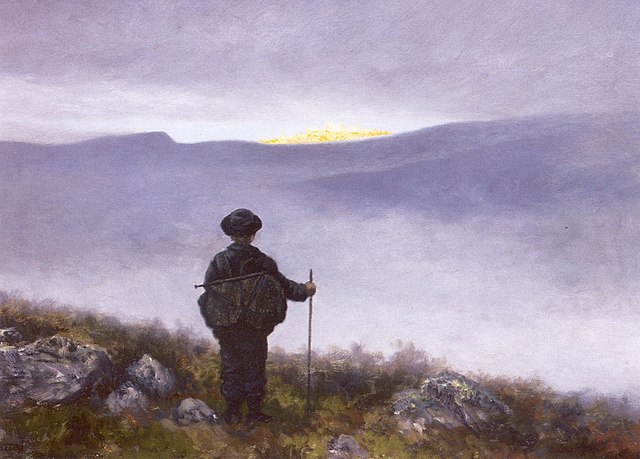Loading AI tools
Norwegian artist (1857–1914) From Wikipedia, the free encyclopedia
Theodor Severin Kittelsen (27 April 1857 – 21 January 1914) was a Norwegian artist. He is one of the most popular artists in Norway. Kittelsen became famous for his nature paintings, as well as for his illustrations of fairy tales and legends, especially of trolls.[1]
Theodor Kittelsen | |
|---|---|
 Theodor Kittelsen (1892) | |
| Born | 27 April 1857 Kragerø, Grenland, United Kingdoms of Sweden and Norway |
| Died | 21 January 1914 (aged 56) Jeløya, Østfold, Norway |
| Nationality | Norwegian |
| Occupation(s) | Artist, illustrator |
| Awards | Royal Norwegian Order of St. Olav |


Kittelsen was born in the coastal town of Kragerø in Grenland, Norway. His father died when he was young, leaving a wife and eight children in difficult circumstances. Theodor was only 11 years old when he was apprenticed to a watchmaker. When at the age of 17 his talent was discovered by Diderich Maria Aall, he became a pupil at Wilhelm von Hannos drawing school in Christiania (now Oslo). Because of generous financial support by Aall he later studied in Munich. However, in 1879 Diderich Aall could no longer manage to support him, so Kittelsen had to earn his money as a draftsman for German newspapers and magazines.[2]
In 1882, Kittelsen was granted a state scholarship to study in Paris, though he would return to Munich at his own expense by the following year.[3] In 1887, he returned to Norway for good, where he would find inspiration in the surrounding nature. He spent the next two years in Lofoten, where he lived with his sister and brother-in-law at Skomvær Lighthouse. Kittelsen also started to write texts to his drawings there.[4]
Kittelsen and his family settled in a home and artist studio which he called Lauvlia near Prestfoss during 1899, where he would spend his best artistic years. During this period, Kittelsen was hired to illustrate Norwegian Folktales (Norwegian: Norske Folkeeventyr) by the Norwegian folklore collector Peter Christen Asbjørnsen and Jørgen Moe. In 1908 he was made Knight of The Royal Norwegian Order of St. Olav. However, he was forced to sell and leave Lauvlia in 1910 due to failing health. Kittelsen was granted an artist’s stipend in 1911; he died in Jeløya in 1914. After his death, his widow Inga Kittelsen was granted an annual salary from the Storting.[5]
Kittelsen's style had elements of Neo-Romantic and naïve painting. As a national artist he is highly respected and well known in Norway, but doesn't receive much international attention, which is the reason that his name is often not included in registers of internationally recognized painters and artists.[6]
Black metal and folk metal bands such as Burzum, Empyrium, Otyg and Satyricon have used some of his pictures as album art, notably illustrations taken from Kittelsen's book Svartedauen (The Black Death). Musician Phil Elverum named the tenth song on his 2017 album A Crow Looked at Me after Kittelesen's painting "Soria Moria" specifically, using it as an illustration of his grief. Kittelsen's 160th birthday was celebrated in a Google doodle on 27 April 2017, giving him some exposure outside of Norway.[8]
Books illustrated by Theodor Kittelsen:[9]
Seamless Wikipedia browsing. On steroids.
Every time you click a link to Wikipedia, Wiktionary or Wikiquote in your browser's search results, it will show the modern Wikiwand interface.
Wikiwand extension is a five stars, simple, with minimum permission required to keep your browsing private, safe and transparent.